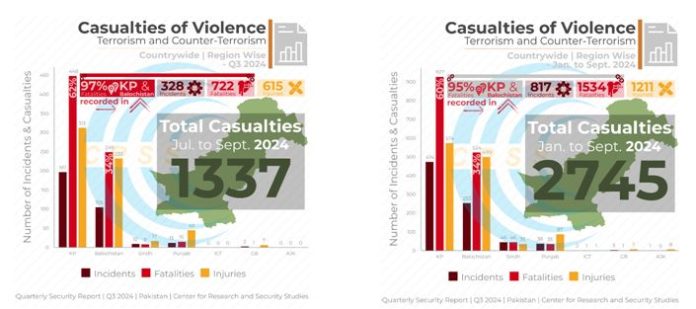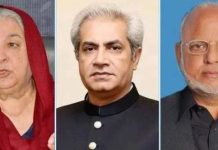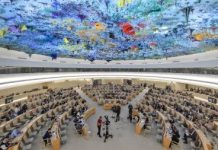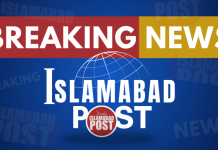BY CENTER FOR RESEARCH AND SECURITY STUDIES (CRSS)
The third quarter of 2024 saw a sharp increase in fatalities of terrorist violence and counter-terrorism campaigns,with a 90% surge in violence. A total of 722 people were killed, including civilians, security personnel, and outlaws, while 615 others were wounded in as many as 328 incidents recorded during the period under review. Nearly 97% of these fatalities occurred in Khyber Pakhtunkhwa (KP) and Balochistan- marking the highest percentage in a decade, and over 92% of these incidents of terror attacks and security forces’ operations were recorded in the same provinces.
The total fatalities from three quarters of this year have now surpassed the total fatalities recorded for the entire 2023; the number of fatalities rose to at least 1534 in the first three quarters compared to 1523 in 2023.
Despite the security forces’ continued anti-terror campaign – on the average at least 112 intelligence-based operations daily (as claimed by ISPR chief Maj General Ahmed Sharif, July22), the state writ over vast swaths of Balochistan and Khyber Pakhtunkhwa has considerably deteriorated – evidenced in the staggering numbers of victims – both security and non-security Pakistanis.
Open outrage by political leaders, people at large and even police – particularly in Lakki Marwat, Bannu, and Swat – against the growing incidence of target-killings and the helplessness of the civilian law-enforcement – also underscores the aggravating security situation, with police increasingly expressing distrust in the military’s control of anti-terror operations. This has invariably eroded the state authority and widened the wedge between the public and the security apparatus.
Meanwhile, terrorist groups continue to reorganize and beef up their ranks. Unverified reports indicate that the number of militant groups aligned with the banned Tehrik-i-Taliban Pakistan (TTP) has swelled to 60, with the latest addition being members of the Naeem Bukhari group from Lashkar-e-Jhangvi, based in Karachi .
Most of the terror attacks remained unclaimed by terrorist or insurgent groups, likely for tactical reasons. However, some groups did take responsibility for some incidents, including the Balochistan Liberation Army (BLA), United Baloch Army (UBA), Tehrik-i-Taliban Pakistan (TTP), and the Gul Bahadur Group. The Iran-based militant group Jaishul-Adl is also suspected of involvement in the killing of five Afghan nationals, whose dead bodies were discovered hanging from electric poles in the Chagai district. Additionally, both Daesh (Islamic State) and its regional affiliate, Islamic State Pakistan Province (ISPP), claimed responsibility for one attack each.

While Punjab and Sindh witnessed a decline in attacks and fatalities, violence in KP and Balochistan surged dramatically, recording a 77% and 159% respective increase in violence. The ongoing anti-terror operations seem to have had minimal impact on the relentless wave of violence if judged by data i.e.90% surge in overall violence between Q2 and Q3, 2024 (with 722 fatalities recorded in Q3and 380 in Q2, 2024).
The worsening security crisis – with the Pakistan military still in charge of most of the security in the newly-merged districts (former Federally Administered Tribal Areas -FATA) prompted Awami National Party (ANP) Central President Aimal Wali Khan to issue a stark warning, claiming that nearly half of KP is now outside the effective control of the police .

In the third quarter, civilians bore the brunt of the violence, followed by security personnel and government officials – accounting for 66% of the total fatalities, with their fatal losses combined, while militant and insurgent deaths made up only 34%. The proportion of attacks targeting civilians, security personnel, and government officials was significantly higher, representing 82% of the total, compared to just 18% resulting from security operations against outlaws. This growing disparity between terrorist attacks and counterterrorism efforts has been a persistent trend, and this quarter was no exception.

In general, the third quarter was marked by an uptick in militant and insurgent fatalities. The sharp rise in civilian and security personnel’s fatalities, nevertheless trumped the losses of outlaws, which denotes an alarming trend in how civilians are once again the target of terrorist groups. Compared to last quarter, the fatalities of civilians and security officials increased by over 100% in this quarter.

The targeting of non-Baloch workers has emerged as a disturbing new trend in militant violence across the country. A total of 38 workers – employed in construction, embroidery, coal mining, and hairdressing – became victims of attacks. The majority of these workers hailed from Punjab, with the exception of three individuals: a Sindhi businessman and two laborers stationed at a Frontier Corps (FC) check post in South Waziristan. Except for the two laborers, all victims were executed in Balochistan.
In one incident alone, as many as 23 workers traveling from Punjab to Balochistan were pulled out from their busses by terrorists in Musakhel and executed them on the spot after ascertaining their Punjabi origins. The Balochistan Liberation Army (BLA) claimed responsibility for this atrocity. Musakhel District, located on the northeastern border of Balochistan and adjacent to KP and Dera Ghazi Khan in Punjab, is a Pashto-speaking region, with 86% of its population speaking Pashto. As a mark of intensified terrorist violence, this was the first time Baloch separatists conducted a deadly operation in a predominantly Pashto-speaking area.
In response to the massacre, the Pakistan Army launched a search operation and claimed to have eliminated about 21 insurgents. However, the clash also led to the martyrdom of 14 soldiers [1].
BLA carried out a suicide attack on an army camp in Lasbela, Balochistan, on August 27, 2024. Notably, one of the suicide bombers was a woman, Mahal Baloch – also known as Zalan Kurd. In a surprising development, a Kurdish organization in Syria, operating in a region under Kurdish control, dedicated its newly inaugurated women’s empowerment center to Mahal Baloch, honoring her as a symbol of defiance[2].
This also suggests a possible nexus among groups which constitute a chain of proxy terrorist groups operating in different regions with the sole objective of destabilisation through indiscriminate terrorist activities.
The sectarian violence in Kurram District was the deadliest incident this quarter, claiming over 100 lives and leaving 143 wounded. The conflict was initially sparked by a land dispute between the Turi (Shia) and Bangash (Sunni) tribes, but the involvement of Tehrik-i-Taliban Pakistan (TTP) militants escalated the situation further.
This also shows how proxy terrorists jump in to exploit internal fault-lines such as shia-sunni conflict.
In addition to the clashes in Kurram, sectarian violence continued to spread elsewhere too. An Ahmadi doctor was gunned down in Alipur village near Lalamusa, Punjab, while Zakir Hussain Baloch, the deputy commissioner of Panjgur, was assassinated in Mastung while en route to Panjgur. The All Pakistan Muslim Zikri Anjuman condemned the killing of Zakir Hussain Baloch and called for swift justice to be served on those responsible[3].












